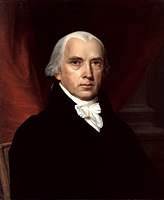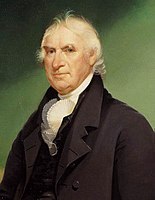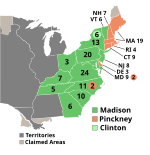
The Twelfth Amendment to the United States Constitution provides the procedure for electing the president and vice president. It replaced the procedure provided in Article II, Section 1, Clause 3, by which the Electoral College originally functioned. The amendment was proposed by the Congress on December 9, 1803, and was ratified by the requisite three-fourths of state legislatures on June 15, 1804. The new rules took effect for the 1804 presidential election and have governed all subsequent presidential elections.

The 1792 United States presidential election was the second quadrennial presidential election. It was held from Friday, November 2, to Wednesday, December 5, 1792. Incumbent President George Washington was elected to a second term by a unanimous vote in the electoral college, while John Adams was re-elected as vice president. Washington was essentially unopposed, but Adams faced a competitive re-election against Governor George Clinton of New York.
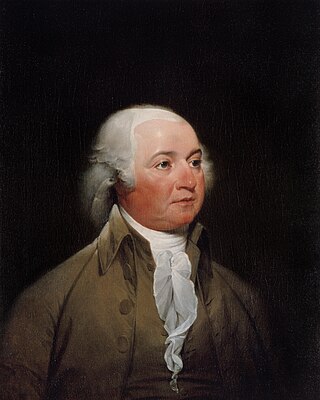
The 1796 United States presidential election was the third quadrennial presidential election of the United States. It was held from Friday, November 4 to Wednesday, December 7, 1796. It was the first contested American presidential election, the first presidential election in which political parties played a dominant role, and the only presidential election in which a president and vice president were elected from opposing tickets. Incumbent Vice President John Adams of the Federalist Party defeated former Secretary of State Thomas Jefferson of the Democratic-Republican Party.

The 1808 United States presidential election was the sixth quadrennial presidential election, held from Friday, November 4, to Wednesday, December 7, 1808. The Democratic-Republican candidate James Madison defeated Federalist candidate Charles Cotesworth Pinckney decisively.
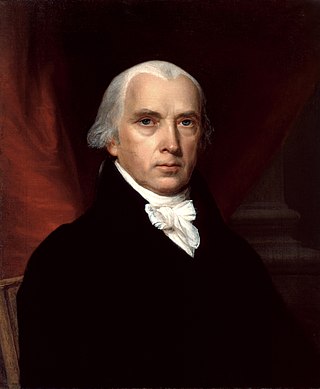
The 1812 United States presidential election was the seventh quadrennial presidential election. It was held from Friday, October 30, 1812 to Wednesday, December 2, 1812. Taking place in the shadow of the War of 1812, incumbent Democratic-Republican President James Madison defeated DeWitt Clinton, the Lieutenant Governor of New York and Mayor of New York City, who drew support from dissident Democratic-Republicans in the North as well as Federalists. It was the first presidential election to be held during a major war involving the United States.

George Clinton was an American soldier, statesman, and Founding Father of the United States. A prominent Democratic-Republican, Clinton served as the fourth vice president of the United States from 1805 until his death in 1812. He also served as the first Governor of New York from 1777 to 1795 and again from 1801 to 1804. Along with John C. Calhoun, he is one of two vice presidents to hold office under two consecutive presidents. He was also the first vice-president to die in office.

In the United States Electoral College, a faithless elector is an elector who does not vote for the candidates for U.S. President and U.S. Vice President for whom the elector had pledged to vote, and instead votes for another person for one or both offices or abstains from voting. As part of United States presidential elections, each state selects the method by which its electors are to be selected, which in modern times has been based on a popular vote in most states, and generally requires its electors to have pledged to vote for the candidates of their party if appointed. A pledged elector is only considered a faithless elector by breaking their pledge; unpledged electors have no pledge to break. The consequences of an elector voting in a way inconsistent with their pledge vary from state to state.

The 2008 United States presidential election in New Jersey took place on November 4, 2008, and was part of the 2008 United States presidential election. Voters chose 15 representatives, or electors to the Electoral College, who voted for president and vice president.

The 2000 United States presidential election in New Hampshire took place on Election Day on November 7, 2000 as part of the 2000 United States presidential election. The 2 major candidates were Texas Governor George W. Bush of the Republican Party and sitting Vice President Al Gore of the Democratic Party. When all votes were tallied, Bush was declared the winner with a plurality of the vote over Gore, receiving 48% of the vote to Gore's 47%, while Green Party candidate Ralph Nader received almost 4% of the vote in the state. Bush went on to win the election nationwide. Had incumbent Vice President Gore come out victorious with New Hampshire and its four electoral votes, he would have won the presidency, regardless of the outcome of Bush v. Gore.

The 2016 United States presidential election was held on November 8, 2016, as part of the 2016 General Election in which all 50 states plus the District of Columbia participated. South Carolina voters chose electors to represent them in the Electoral College via a popular vote pitting the Republican Party's nominee, businessman Donald Trump, and running mate Indiana Governor Mike Pence against Democratic Party nominee, former Secretary of State Hillary Clinton and her running mate, Virginia Senator Tim Kaine.

The 2016 United States presidential election in Alaska was held on Tuesday, November 8, 2016, as part of the nationwide presidential election in which all 50 states plus the District of Columbia participated. Alaska voters chose electors to represent them in the Electoral College via a popular vote, pitting the Republican Party's nominee, businessman Donald Trump, and running mate Indiana Governor Mike Pence against Democratic Party nominee, former Secretary of State Hillary Clinton, and her running mate Virginia Senator Tim Kaine. Alaska has three electoral votes in the Electoral College.

In the 2016 United States presidential election, ten members of the Electoral College voted or attempted to vote for a candidate different from the ones to whom they were pledged. Three of these votes were invalidated under the faithless elector laws of their respective states, and the elector either subsequently voted for the pledged candidate or was replaced by someone who did. Although there had been a combined total of 155 instances of individual electors voting faithlessly prior to 2016 in over two centuries of previous US presidential elections, 2016 was the first election in over a hundred years in which multiple electors worked to alter the result of the election.

The 1812 United States presidential election in New York took place between October 30 and December 2, 1812, as part of the 1812 United States presidential election. The state legislature chose 29 representatives, or electors to the Electoral College, who voted for President and Vice President.

The 1812 United States presidential election in Maryland took place on an unknown date in 1812, as part of the 1812 presidential election. Voters chose eleven representatives, or electors to the Electoral College, who voted for President and Vice President.

The 1808 United States presidential election in Massachusetts took place between November 1 and 8, 1808, as part of the 1808 United States presidential election. Voters chose 19 representatives, or electors to the Electoral College, who voted for President and Vice President.

